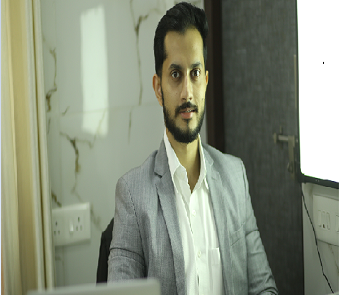
Dr Karan Kishor Mane , M.S.(Orthopaedics), is a fellowship trained orthopaedic surgeon speciallizing in the field of joint replacement surgeries. He completed his graduation and Masters in Orthopaedics from JNMC Sawangi, DMIMS, Nagpur.
He has worked at R.N. Cooper Hospital , Juhu, Mumbai and BR Ambedkar Hospital Mumbai and went on for speciallized Fellowship by Depuy (J&J) in joint replacement surgeries to Mumbai, where he worked for 6 months in the joint replacement division.
He has also done a Fellowship at Sunshine Hospitals, Secundarabad, under Dr Gurava Reddy. Sunshine hospital is one of the best joint replacement facility in India, with more than 4000 surgeries being performed each year. There he performed and assisted more than 500 joint replacement surgeries.
He received the prestigious Rizzoli Orthopaedic Institute Fellowship, where he got to work in the field of Revision Hip and Knee arthroplasty, under the guidance of Dr Giovanni Pignatti. The Rizzoli Orthopaedic Institute is a centre of excellence on several fronts which includes implantation of hip prostheses (Primary and revision) The clinical work of prosthesis implantation and revision is supported by the scientific research of several laboratories working on implant design, prosthetic materials and techniques.
Dr.Karan Kishor Mane has attended and been a part of a lot of conferences, workshops and CME’s. Dr.Karan Kishor Mane is also working as Asst. Professor and a faculty in the Department of Orthopaedics at Lata Mangeshkar Hospital.
Knee replacement, also called arthroplasty, is a surgical procedure to resurface a knee damaged by arthritis. Metal and plastic parts are used to cap the ends of the bones that form the knee joint, along with the kneecap. This surgery may be considered for someone who has severe arthritis or a severe knee injury. During knee (or total knee) replacement surgery, joint surfaces are substituted or replaced by prostheses. The goal of knee replacement surgery is to resurface the parts of the knee joint that have been damaged and to relieve knee pain that cannot be controlled by other treatments.

Hip replacement, also called total hip arthroplasty, is a surgical procedure to replace a worn out or damaged hip with an artificial joint (prosthesis). This surgery may be considered following a hip fracture (breaking of the bone) or for someone who has severe pain due to arthritis Hundreds of thousands of artificial hip replacement surgeries are performed yearly. Hip replacement may become necessary if activities such as walking, sitting, or even resting become painful. The goal of hip replacement surgery is to replace the parts of the hip joint that have been damaged, and to relieve hip pain that cannot be controlled by other treatments.
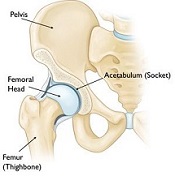
Arthritis is very common but is not well understood. Actually, “arthritis” is not a single disease; it is an informal way of referring to joint pain or joint disease. There are more than 100 different types of arthritis and related conditions.
Common arthritis joint symptoms include swelling, pain, stiffness and decreased range of motion.
Our team of expert surgeons is lead by Dr Karan Mane who is trained in both primary as well as revision joint replacement .
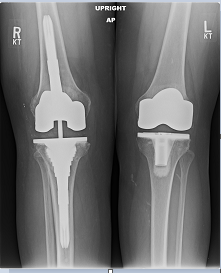
Arthroscopy is a surgical procedure orthopaedic surgeons use to visualize, diagnose, and treat problems inside a joint. The word arthroscopy comes from two Greek words, "arthro" (joint) and "skopein" (to look). The term literally means "to look within the joint." In an arthroscopic examination, an orthopaedic surgeon makes a small incision in the patient's skin and then inserts pencil-sized instruments that contain a small lens and lighting system to magnify and illuminate the structures inside the joint. Light is transmitted through fiber optics to the end of the arthroscope that is inserted into the joint. By attaching the arthroscope to a miniature television camera, the surgeon is able to see the interior of the joint through this very small incision rather than a large incision needed for surgery. The television camera attached to the arthroscope displays the image of the joint on a television screen, allowing the surgeon to look, for example, throughout the knee. This lets the surgeon see the cartilage, ligaments, and under the kneecap. The surgeon can determine the amount or type of injury and then repair or correct the problem, if it is necessary. The procedure is useful for treating injuries of meniscus , ligaments, avulsion fractures, removal of inflamed synoviumand repair of torn ligaments around knee, shoulder, hip and wrist.

The word “Fracture” implies to broken bone. A bone may get fractured completely or partially and it is caused commonly from trauma due to fall, motor vehicle accident or sports. Thinning of the bone due to osteoporosis in the elderly can cause the bone to break easily. Overuse injury is a common cause of stress fractures in athletes.
Types of fractures include:
• Simple fractures in which the fractured pieces of bone are well aligned and stable.
• Unstable fractures are those in which fragments of the broken bone are misaligned and displaced.
• Open (compound) fractures are severe fractures in which the broken bones cut through the skin. This type of fracture is more prone to infection and requires immediate medical attention.
• Greenstick fractures: This is a unique fracture in children that involves bending of one side of the bone without any break in the bone.
Fracture Healing : Our body reacts to a fracture by protecting the injured area with a blood clot and callus or fibrous tissue. Bone cells begin forming on either side of the fracture line. These cells grow towards each other and thus close the fracture.
Medical Therapy :The objective of early fracture management is to control bleeding, prevent ischemic injury (bone death) and to remove sources of infection such as foreign bodies and dead tissues. The next step in fracture management is the reduction of the fracture and its maintenance. It is important to ensure that the involved part of the body returns to its function after the fracture heals. To achieve this, maintenance of fracture reduction with immobilization technique is done by either non-operative or surgical methods.
Non-operative (closed) therapy comprises of casting and traction (skin and skeletal traction).
• Casting
Closed reduction is done for any fracture that is displaced, shortened, or angulated. Splints and casts made up of fiberglass or plaster of Paris material are used to immobilize the limb.
• Traction
Traction method is used for the management of fractures and dislocations that cannot be treated by casting. There are two methods of traction namely, skin traction and skeletal traction.
Skin traction involves attachment of traction tapes to the skin of the limb segment below the fracture. In skeletal traction, a pin is inserted through the bone distal to the fracture. Weights will be applied to this pin, and the patient is placed in an apparatus that facilitates traction. This method is most commonly used for fractures of the thighbone.
Surgical Therapy :• Open Reduction and Internal Fixation (ORIF)
This is a surgical procedure in which the fracture site is adequately exposed and reduction of fracture is done. Internal fixation is done with devices such as Kirschner wires, plates and screws, and intramedullary nails.
• External fixation
External fixation is a procedure in which the fracture stabilization is done at a distance from the site of fracture. It helps to maintain bone length and alignment without casting.
External fixation is performed in the following conditions:
• Open fractures with soft-tissue involvement
• Burns and soft tissue injuries
• Pelvic fractures
• Comminuted and unstable fractures
• Fractures having bony deficits
• Limb-lengthening procedures
• Fractures with infection or non-union
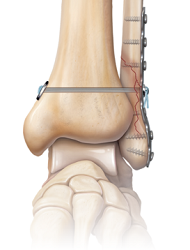
Arthritis is a joint disorder featuring inflammation. A joint is an area of the body where two bones meet. A joint functions to allow movement of the body parts it connects. Arthritis literally means inflammation of one or more joints. Arthritis is frequently accompanied by joint pain. Joint pain is referred to as arthralgia. There are many forms of arthritis (over 100 have been described so far, and the number is growing). The forms range from those related to wear and tear of cartilage (such as osteoarthritis) to those associated with inflammation as a result of an overactive immune system (such as rheumatoid arthritis). Together, the many forms of arthritis make up the most common chronic illness. The burden of arthritis conditions can be reduced through intervention at various points along the disease continuum including prevention, early diagnosis, prompt initiation of treatment and ongoing management. Although some chronic disease risk factors (for example, family history, age or sex) are not able to be modified and so cannot be incorporated into prevention strategies, they can help to identify people or groups at high risk of developing a disease, enabling a targeted approach.
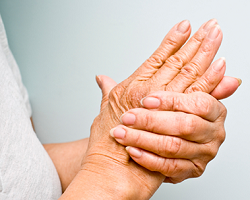
Icons Department of Orthopaedic Surgery provides comprehensive trauma and fracture care for patients in need. Our orthopaedic trauma surgeons are available and on-call to treat orthopaedic injuries and fractures 24 hours a day.
The Orthopedic Trauma Service (OTS) at Icon Hospital Nagpur are fully equipped and have an expertise in providing orthopedic emergency care. We treat all fractures; including the upper extremity and lower extremity, pelvis, acetabulum and other bones and joints, isolated fractures/dislocations, and polytrauma. Additionally, we treat nonunions and malunions including cases requiring deformity correction.
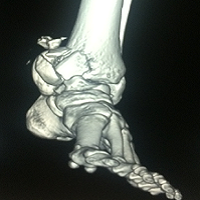
If you have osteoarthritis that affects your knees, an injection of hyaluronic acid could help ease your pain and stiffness. People with arthritis get these shots to help lubricate their joints so that they work more smoothly. Your doctors at Iconwill let you know if it would help you, based on your symptoms and other treatments you’ve tried. Though the shots have been available for more than a decade, studies on how effective they are have shown good results. How They Work Normally, synovial fluid (which is found in hyaluronan, a substance throughout the body's soft tissues that helps with joint health) lubricates your joints. If you have osteoarthritis, your supply of synovial fluid has thinned. The procedure is simple. Your doctor injects hyaluronic acid directly into the area around your knee joint. Pain relief is usually obtained by four to 12 weeks, and the effect has been shown to last for up to several months. The treatment can be repeated as necessary.

| Department | Doctor Name |
|---|---|
| Reproductive Medicine, Infertility and IVF | Dr. Indrayani Hatwar |
| Dr. Nishad Chimote | |
| Dr. Namrata Rathod | |
| Dr. Mira Har Prasad | |
| Pediatric & Neonatal Surgery, Urology, Laparoscopy & Bronchoscopy |
Dr. Sandeep Hatwar |
| Join Replacement & Orthopaedic Surgeon |
Dr. Karan Kishor Mane |
| Anaesthesia & Critical Care | Dr. Ravi Gurbani |
| Dr. Poonam Patil | |
| Dr. Gunjan Badwaik | |
| Dr. Jagdish Rathod | |
| Pathology | Dr. Vikas Ingale |
| Bariatric & Minimal Access Surgery | Dr. Ahsan Badar |
| General Surgery & Laparoscopy | Dr. Madhukar Thakare |
| Dr. Yunus Shah | |
| Dr. Pitambar Masram | |
| General Medicine & Critical Care | Dr. Saurabh Rathi |
| Dr. Sameer Dasarwar | |
| Opthalmology | Dr. Rahul Tiwari |
| Plastic Surgery | Dr. Manish Zade |
| Urology | Dr. Sandeep Deshmukh |
| Neurosurgery | Dr. Pankaj Sarda |
| Dr. Yogesh Shende | |
| ENT | Dr. Bhagyeshree Lonkar |
| Faculty |
|---|
| IVF Specialist |
| Embryologist |
| Obstetrician & Gynaecologist |
| Obstetrician & Gynaecologist |
| Pediatric Surgeon |
| Joint Replacement & Orthopaedic Surgeon |
| Anaesthetist & Intensivist |
| Anaesthetist |
| Anaesthetist |
| Anaesthetist |
| Pathologist |
| Bariatric Surgeon |
| Laparoscopic & General Surgeon |
| Laparoscopic & General Surgeon |
| Laparoscopic & General Surgeon |
| Intensivst & Physician |
| Intensivst & Physician |
| Vitro-Retinal Surgeon |
| Plastic Surgeon |
| Urologist |
| Neurosurgeon |
| Neurosurgeon |
| ENT Surgeon |